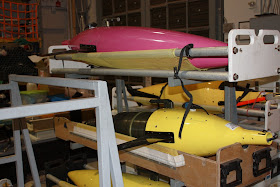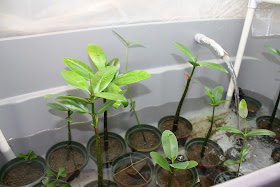Our 4H club had the awesome opportunity this week to tour the University of Washington Ocean Sciences building and learn about the Paleoclimatology & Organic Geochemistry Research being done there. We feel really fortunate to have access to this great teaching, learning and research institution. The visit was a wonderful example for the kids of what can be accomplished with an interest in the natural world combined with a solid game plan and lots of hard work.
Paleoclimatology is the study of changes in climate over the entire history of the Earth. Researchers learn about these changes by looking at ocean currents, temperatures, salinity, atmospheric gasses and very, very old slices of history...literally. Much of their data comes from deep sediment and ice core samples collected in various places all over the world. Information about what our atmosphere was like thousands of years ago can be compared to today's data and much can be learned.
 |
| This is a device that collects samples in the open ocean. |
 |
| We learned that our oceans are mapped just like our land masses are. |
The kids were very interested in the nitty gritty, practical details of how data is collected by the research team. Members of the team spend several months each year out in the field collecting data in places like the Marshall Islands, Fiji and the Galapagos Islands. The University has developed and manufactures self propelled Deepglider devices that travel through the oceans of the world collecting information in a much more efficient way than in the past when research boats and many people would be needed to achieve the same result.
 |
| Deepgliders getting readied for testing. |
The lab has a test tank where they are able to do trial runs with equipment before taking it out into the field. We got to try it out for ourselves.
Many parts of the lab facilities contain high tech industrial-looking equipment. It was a good reminder that science is not only about lab coats, beakers and microscopes.
There were temperature controlled rooms containing core sediment samples in various stages of analysis. The oldest core sample we saw was 120,000 years old. It was also interesting to learn that some really low-tech tools like cheese wire and plastic wrap play important roles in the whole process.
The researchers also look for information in living things like plants that help measure saline levels in the earth's oceans. Every single variable has to be looked at in order for the research to be valid and meaningful.
It was fun to see evidence that this was a real, working lab with people leaving notes out for each other. I leave notes out on my counter too, but mine usually say something like "buy peanut butter". Hmmm.
The high point for most of the kids was when they got to see the power of liquid nitrogen which, at -346°F, is the coldest thing that exists on Earth. We dipped several objects in liquid nitrogen (gummi bears, roses, bananas, pennies and balloons) and got to see how extreme cold effects different substances. It's a well known fact that scientists kick everyone's butt in the party trick department.
Upon departure we were also reminded that scientists do humor too.
Thanks University of Washington Paleoclimatogy & Organic Geochemistry folks! And keep up the good work!
.












Great activity for the kids!!!!
ReplyDeleteProcurement Resources is a website providing detailed price trends where you will find detailed information about more than 500 products, here you will find detailed price trends for many products like ethanol price, toluene price. Then definitely visit the website of Procurement Resources once.
ReplyDeleteexperience, Realme 8 Pro is the best choice.
ReplyDeleteCompanies like Vivo, Realme, Xiaomi are producing the best budget gaming phones to meet increasing demand. If you wonder which gaming smartphone you should buy, we are enlisting a few phones equipped with powerful processors, improved battery life, and display with a high refresh rate to support a non-stop gaming experience.